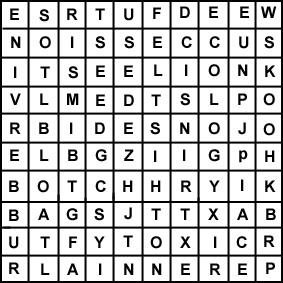 Activities
Activities
Module 1: An Introduction to weeds
Activity 1-1
Have a look at a nearby pasture, crop, bush site, or conservation area and work out approximately what percentage of the species present are alien and what percentage are native. Compare several diverse sites and consider the differences.
Activity 1-2
Have a look at the image collection showing a range of weed types to remind yourself of the diversity of plants we call weeds. See if you can classify them according to their grass morphology (eg. Herbaceous, broadleaf, wood, perennial etc.).
Activity 1-3
Answer the following questions:
- Explain the human centred and species centred views of what constitutes a 'weed'.
- List at least eight ecologically significant characteristics of weeds.
- How does the formation of local races in weeds influence their success?
- What is the nature of the relationship between the distribution of aliens in Australia and their areas of origin?
- What are the different impacts that weeds have in amenity and nature reserves compared with arable and horticultural crops?
- What advantages does correct weed identification provide for effective weed management?
Module 2: Legislation and weeds
Activity 2-1
Answer the following questions:
- Describe the benefits and drawbacks of legislating weed control.
- Describe the three main stages of weed invasion?
- In which stage of weed invasion might it be feasible to implement eradication strategies for a weed?
- Why will eradication be unsuccessful in the other stage(s)?
Module 3: Economics and decision making in weed management
Activity 3-1
Answer the following questions:
- Describe five types of losses that a farmer will suffer due to weeds.
- Describe how short and long term planning horizons can influence weed control decisions.
- What is the difference between a benefit/ cost analysis (BCA) and a gross margin analysis (GMA)?
- What is an opportunity cost and how might a farmer suffer from an opportunity cost caused by weeds?
Module 6: Environmental weeds
Activity 6-1
- Define the following terms: environmental weed, serious environmental weed, and very serious environmental weed, with examples.
- What life-forms of plants can become environmental weeds?
- List four types of disturbance of Australian native ecosystems that allow weeds to invade.
- How long does it typically take between initial establishment of a weed and it becoming a serious environmental weed? What are the consequences for our future serious environmental weeds?
Module 8: Rangelands weeds
Activity 8-1
Two serious pasture weeds in Northern Australia – view the clips Parthenium weed creeps towards NSW; and Prickly acacia on the DVD ‘Weeds in the Way’, available from the UQ Gatton Library.
Activity 8-2
- What is the relevance of weed life history, germination and dormancy to pasture weed control?
- What is l and why is this a useful parameter for studying weed competition?
Module 9: Cropping weeds
Activity 9-1
The answers to the clues are hidden below, they may horizontal, vertical or diagonal.
Activity 9-2
Answer the following questions:
- Describe the difference between competition and interference.
- Name three resources that weeds compete for.
- Describe the relationship between weed density and crop yield. How might this relationship vary for different weeds?
- Define the three different types of seed dormancy.
- What factors are essential for the germination of weed seeds? How does burial of seeds affect germination?
Activity 9-3
Match the common name of the weed with the scientific name, in the table below:
Module 10: Physical management
Activity 10-1
Answer the following questions:
- Describe the three main objectives of tillage
- Describe the impact of the various tillage implements on soil, existing vegetation and weed seeds.
- What are the differences between the terms minimum and zero tillage? How do weeds respond to these two tillage systems?
Module 11: Grazing management
Activity 11-1
Answer the following questions:
- Define selective grazing. What is the effect of selective grazing on a pasture?
- List some direct effects of grazing on plants.
- What types of weeds are best grazed by goats rather than sheep or cattle?
- How can rests and mob stocking be used to manage some weeds. Give an example.
- What factors might constrain the successful use of mob stocking for controlling some weeds?
Module 12: Cropping management
Activity 12-1
Answer the following questions:
- What is the impact on weeds of a simple compared to a complex crop rotation?
- Name three characteristics typical of highly competitive cereal cultivars.
- What tactics other than choice of crop and cultivar can be used to provide a more competitive crop?
- How might changes in sowing date be used to influence weed numbers?
Module 13: Biological control
Activity 13-2
Complete the crossword below:
 |
Across Down |
Module 14: Herbicide mode of action
Activity 14-1
Match the herbicide chemical group with the symptom, in the table below:
|
Module 15: Herbicide application and fate in the environment
Activity 15-1
Answer the following questions:
- Describe the essential steps in efficient and accurate application of herbicides.
- Describe three methods of herbicide application.
- What are the important characteristics of spray droplets of less than 100 µm or greater than 300 µm diameter, that make these droplets unsuitable for post emergent herbicide applications?
- What processes contribute to herbicide drift and how can drift be minimised?
- Describe the features of herbicides that will lead
to strong and weak adsorption to soil components?
How will soil properties influence adsorption? - Describe how a herbicide such as atrazine enters plants and its fate within plants?
Module 16: Herbicide resistance in weeds
Activity 16-1
Answer the following questions:
- How do the initial gene frequency for resistance and the size of weed populations treated with herbicide interact in the evolution of herbicide resistance?
- Explain why there might be more resistance to Group B herbicides than to Group D herbicides in Australia.
- Describe the relative importance of pollen and seed movement for the spread of herbicide resistance.
- Describe three biochemical mechanisms that can endow herbicide resistance in weeds.
Module 17B: Integrated weed management in a pasture system
Activity 17B-1
As an exercise, have a look at some nearby pastures and see if the level of weed infestation relates to the amount of standing pasture dry matter.
